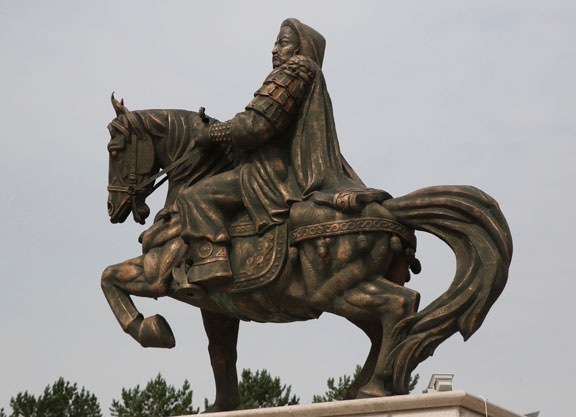By Lucas Marquardt
ORDOS, CHINA–It is Monday morning, the day after the Chinese Equine Cultural Festival in Ordos wrapped with a fun four-race card at Yiqi Race Course, and the weather is overcast and breezy. It's a welcome change after a weekend that was sticky hot.
From the abundance of work and other vices, there are some sluggish gaits and some missing faces from the group as we pile onto a tour bus at 9 a.m. The bus's destination is the Genghis Khan Mausoleum, about an hour away.
We drive through the streets of Ordos, and even on Monday morning, the city feels relatively empty. (“Yes, we get it,” I can hear you say. “Big city, not many people. Move on.”) (But I can't move on. It gives you a strange feeling. The best I can describe it is this: Have you ever been outside, and suddenly become aware that the birds and insects and everything else has stopped making noise. And you know that something weird is about to happen? It's like that.)
Anyway, out past the newly built Kangbashi district, out past the Ordos Sports Center Stadium and its two sister complexes, out past Yiqi Race Course, you start to get into rural Ordos, and the fields open and you begin to see dozens of Mongolian horses dot the landscape. In the areas that haven't been fenced off for pasture, there are many trees, but few tall ones, and the landscape rolls like it does in Kentucky, so that in the right spot you can see many miles in each direction.
Mongolian horses are interesting little fellows. They aren't very big–ranging from 12 to 14 hands and weighing about 600 pounds–but they're rugged and sturdy, and evidently haven't changed all that much since the time of Genghis Khan. They may, in fact, be the least regal of the equine breeds, and it's amusing to think of them, with their choppy gallop and oversized heads, charging into battle with fearsome warriors on their backs.
We arrive at the mausoleum at 10, and it's easily the most people I've seen in public since I've been in Ordos, excepting Sunday at the track. (“Really, we get it. Not a lot of peeps. Move on.”)
Entering through a large gateway, there are five or six broad, long plazas, with steps leading up to the next one. There are 99 steps in total that lead to the mausoleum, nine being a number significant in Chinese numerology.
Numbers play a big role at the mausoleum. The round plaza that sits midway to the main buildings is 66 meters in diameter; 66 the age at which Genghis Khan died, from non-battle internal injuries, after falling from his horse while hunting. From what I gathered from the tour guide, there are the images of 1227 dragons at the mausoleum. In Mongolian lore, dragons are the only animal in heaven, and 1227 is the year that Genghis Khan died.
The main building is long, with three grand halls connected by breezeways, each shaped like a Mongolian yurt. A white marble statue of Genghis Khan sits in the main building. There's a prayer area in back, and in each of the halls to the side are historical objects and replicas dating back to the period.
It's probably a good time to mention that Genghis Khan wasn't actually buried here; he was buried in an unmarked grave, and despite several archeological searches, no one is really sure of his final resting place. (The story goes that the funeral party killed everyone to and from the burial spot, so as to keep it a secret.)
Over time, portable mausoleums were erected in Genghis Khan's honor. The current site was built in 1954 and, after being ransacked by the Red Guard during the Cultural Revolution, rebuilt a few years later, minus some treasured artifacts that were destroyed.
This also might be a good time to put an asterisk beside the general adoration bestowed on Genghis Khan by those of Mongol descent here. On one hand, the adoration is understandable. The man united the Mongal tribes and brought glory to the Mongol people by establishing the world's largest-ever empire. He is also said to have embraced religious tolerance and meritocracy, AND established one of the world's first international postal systems (!). On the other hand…he is thought to have slaughtered some 40-million people during his military crusades. I won't get too into it, but if you want to spend an interesting, wide-eyed afternoon in front of your computer, start Googling.
Now, this is definitely a good time to mention that I do realize that this is a horse racing journal, and absolutely none of this has anything to do with racing. But when I travel, these cultural and historical adventures wind up being some of favorite parts of the trip, and I hope some of you enjoy the random facts of a place you might not have visited before.
To wrap things up, I want to say thanks to my hosts from the China Horse Club and its founder, Mr. Teo Ah Khing, as well as the Club's Michael Wallace, Chris Richards and Mick Flanagan. And to Elona Wong, who helped me get to China in the first place. To reference Monday's column, it's been a real education.
On Sunday, after the races, I was standing next to bloodstock agent Tom Ryan as the fireworks began going off, the show stretching from one end of the track to the other. Ten minutes later, I leaned over and said, “Man, this is the best fireworks show I've ever seen.” Tom said, “I agree. Teo doesn't do anything small, and he does it right.”
That, I feel, is a good way to sum up the potential of the China Horse Club, and perhaps the future of racing in China in general.
Not a subscriber? Click here to sign up for the daily PDF or alerts.






